When mentioned, "Kailash Mansarovar" conjures up images of sublime peaks, silent lakes, and intense spiritual awakenings. The trip to Mount Kailash and Lake Mansarovar is counted among the greatest spiritual pilgrimages in the lives of millions of followers of Hinduism, Buddhism, Jainism, and Bon, the way toward nirvana and reunification with God. If for you the Yatra has been only a dream for years or you have just recently brought it into consideration with all its deeper significance, then the very first step is to get an understanding of what awaits you so as to start converting that dream into an actual blessed journey.
Given Mount Kailash's high height, rich cultural heritage, and hard terrain, trekking requires more than just passion; it also requires attention to detail and an awareness of the unique demands and obstacles. In regards to that, countless questions come to light : from the hassles of acquiring a visa, coping with demanding high-altitude walks, sorting out packing lists, to finally witnessing and maintaining utmost respect for the local Tibet aspirations.
You will discover all the information you need to organize your Kailash Mansarovar Yatra, from the fascinating history of the sacred mountain to the snowstorms that cause the mountain glaciers to glide. We highlight those ominously titled "things to know" that could make the difference between hardship and a true inner metamorphosis in order to help you go a step further and with preparations and practicalities. That is to say, your Kailash Mansarovar Yatra would become a pilgrimage with a working consciousness, grounded and possessed of preparation, and most importantly, an open heart.
What is Kailash Mansarovar Yatra?
Kailash Mansarovar Yatra is a sacred pilgrimage destined to Mount Kailash and Lake Mansarovar, two among the most sacred sights in the Himalayas. Hindus believe Mount Kailash is the abode of Lord Shiva and Goddess Parvati, whereas Lake Mansarovar is considered the holiest of all lakes as it was formed from Brahma's mind. It is equally important to Buddhists, Jains, and Bon followers. To the Buddhists, it is believed that Mount Kailash is the residence of Demchok, an immensely powerful deity, while Jains believe that the mountain is where their first Tirthankara, Rishabhanatha, attained liberation. Thus, the pilgrimage is a step towards spiritual purification, liberation (moksha), and deep connection to the divine.
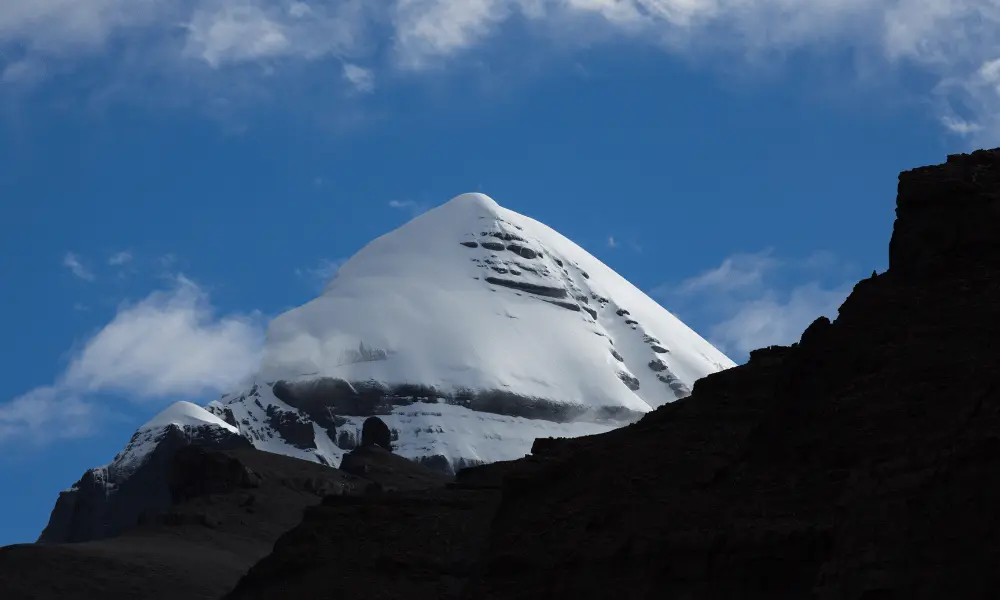
It is challenging yet extremely rewarding which involves circumambulating Mount Kailash (parikrama or kora), that lasts three days, and bathing in the pure waters of Lake Mansarovar. The trip is physically demanding, given the high altitude, rough terrain, and quite unpredictable weather in a very secluded Tibetan Autonomous Region of China where the sites lie. The pilgrims have to cross a tough pass, Dolma La Pass, which adds to the spiritual vigor and physical intensity of the Yatra.
Of course, visiting Kailash is a very demanding journey, but traversing the terrain is also transformative in the spiritual sense. The ethereal beauty spread across the Himalayas mingled with intensity emanated from the spiritual sites creates an unmatched aura for self-development and worship. A spiritual achievement so rare, completing the Kailash Mansarovar Yatra stands testimony to spirit, utmost faith, and sheer dedicatory will to the divine.
Learn More: Kailash Mansarovar Yatra
List of Things to Know
Here’s a list of things to know when visiting Kailash Mansarovar:
|
Spiritual and Cultural Significance |
|
Best time to Visit |
|
Major Attractions |
|
Travel Documents and Permits |
|
Routes and Journey Options |
|
Packing Essentials |
|
Food and Accommodation |
|
Health and Insurance |
|
Challenges of the Yatra |
|
Things Not to Do |
Spiritual and Cultural Significance
The Kailash Mansarovar Yatra is one of the most sacred pilgrimages in the world, deeply rooted in the spiritual beliefs of Hindus, Buddhists, Jains, and followers of the ancient Bon religion.

Hinduism
For Hindus, the spiritual land of Kailash Mansarovar has incomparable importance as the seat of Lord Shiva, the destroyer and transformer in the Holy Trinity of Brahma, Vishnu, and Maheshwara (Shiva). Mount Kailash, they believe, is at the cosmic axis of the universe, and walking around it, the Kailash Parikrama, is said to be an act that cleanses the human soul. Mansarovar Lake is believed to contain a potent spiritual energy, its waters capable of washing a person of sins and bestowing moksha, or freedom from death and rebirth.
Buddhism
From the point of Tibetan Buddhism, Mount Kailash is believed to be the abode of Cakrasamvara Buddha, also known as Demchok. Additionally, devotees believe that circumambulation of the mountain aids in gaining enlightenment. In the Buddhist teachings, Master Padmasambhava or Guru Rinpoche is associated with Mount Kailash, for he is said to have introduced Buddhism to Tibet. The circumambulation of Kailash is a metaphor for a transformative process symbolizing the practitioner's own movement toward enlightenment. The vicinity of Mount Kailash is indeed believed to be the residence of divine beings and a sanctuary for the meditation of great sages; hence, it is a worthy pilgrimage site for Buddhists seeking spiritual inclinations and insights.
Jainism
The journey to Kailash is considered an immensely sacred pilgrimage in Jainism since Mount Kailash, called 'Ashtapada' in Jain scriptures, is considered an abode where the first Tirthankara of theirs, Rishabhanatha (Adinath), attained moksha (liberation from the cycle of rebirth), qualifying it as a prime Siddha-Kshetra, where one has attained ultimate spiritual achievement and purification.
Bon
For Bon practitioners, the native Tibetan religion, Kailash is considered to be the sacred nine-story Swastika Mountain that ascends to the heavens. The Bon religion, antedating Buddhism in the Tibetan area, also considers Kailash Mansarovar sacred. In Bon, Kailash is known as the "Nine-Story Swastika Mountain" and is considered to be a seat of spiritual power and abode of gods. Circumambulation of Kailash is considered a sadhana to accrue spiritual merit and enlightenment in the Bon religion.
Best Time to Visit
The best months to have the Kailash Mansarovar Yatra go ahead are May to September. The warmer months of late spring, summer, and early autumn offer favorable weather for the pilgrimage. The temperature averaged between 15°C and 20°C, a very comfortable range for trekking.

The detailed breakdown is mentioned below:
- May-June: Warmer weather talks of bright skies and pleasant temperatures. Little snow notwithstanding, the roads remain open, making for smooth and safe travel. The region is at its full scenic beauty, adorned with green vistas and fresh blooms all along.
- July-August: These two months mark the peak season of the yatra, with pleasant weather and long days selling the idea of easy travel and plenty of time to savor the spiritual and scenic topographies along the way. Thankfully, rains remain negligible in this window.
- September: The yatra is at its best in September, as the region changes color for fall. Weather is beautifully cool, with less rainfall than during summer. The blue sky adds to its superb views of Mount Kailash and the adjoining countryside. Moreover, this time has fewer crowds, offering you a more intimate experience with the region.
Saying that it is advisable to have the pilgrims plan their pilgrimage within this timeframe so as to maximize the chances of having a smooth transition as well as a spiritually enriching experience amidst the breathtaking Kailash Mansarovar scenery.
Learn More: Best Time to Visit Kailash Mansarovar
Major Attractions
The Kailash Mansarovar Yatra offers a long route filled with some major attractions that cover nature's marvel and spiritual value. Going from Mount Kailash all the way down to serene Mansarovar Lake, every pitstop-given Yam Dwar, Dolma La Pass, Chiu Monastery has special beauty and spiritual vibration. This trip weaves an enchanting journey that, over the unearthly mystery of Kailash Mansarovar, erects a realm of holiness and spirituality where both devotees and tourists must walk through.
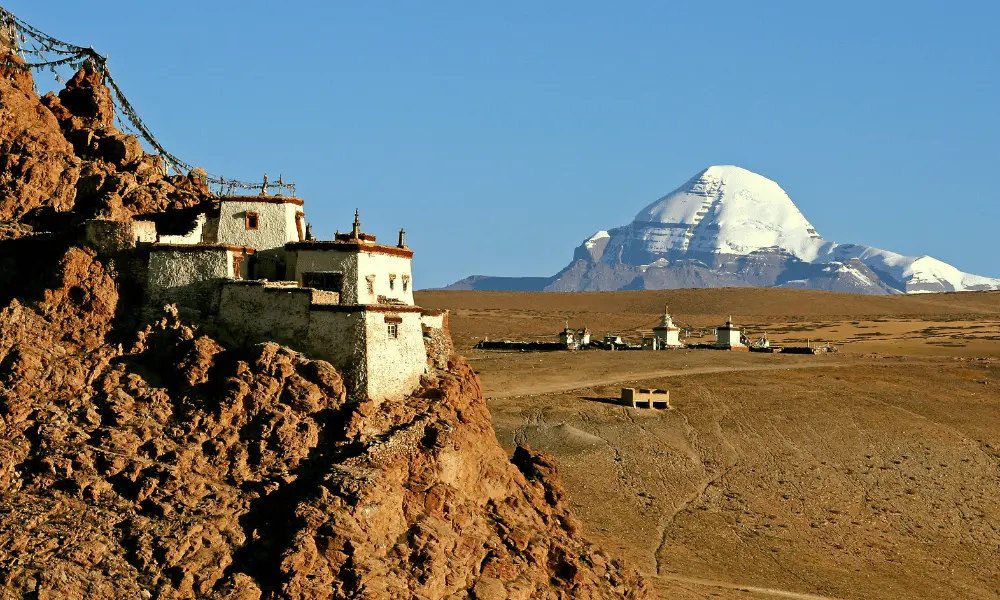
Some of the significant stops along the way are:
Mount Kailash
Mount Kailash, with a height of 6638 meters, is the spiritual center of the Kailash Mansarovar Yatra. Situated in the isolated western region of Tibet, it is considered by Hindus as the realm of Lord Shiva. The Buddhists esteem the mountain as the residence of their deity, Demchok, while the Jainas see it as the place where their first Tirthankara attained liberation, and the Bonas regard it as a mountain of power. Out of respect for the religious sentiments involved, the peak has never been climbed. A difficult pilgrimage is laid out for the pilgrims, a 52-kilometer circumambulation called the Kailash Kora or Parikrama, along which the ritual paving is believed to wipe out sins and bring spiritual awakening.
Lake Mansarovar
Situated near Mount Kailash, Lake Mansarovar is among the world's highest lying freshwater lakes, at roughly 4600 meters elevation. In Hindu mythology, it says that the lake was created by the power of Lord Brahma's mind; hence the word 'Manas' (mind) + 'Sarovar' (lake). Thus, it is regarded as an origin of purity and divinity. It is believed that taking a bath from the waters of this lake can remove sins of his/her life. It is a really cool sighting when the calm beauty of the lake reflects Mount Kailash; it is awe-inspiring and deeply spiritual.
Chiu Monastery
This Chiu Monastery, also called the Chiu Gompa, is a famous Buddhist monastery sitting atop a rocky hill above the sacred Lake Mansarovar in Tibet, some 33 kilometers from Darchen-the base for Mount Kailash pilgrimages. The name means "sparrow," given to the place because a sparrow guided Guru Rinpoche (Padmasambhava), who brought Tantric Buddhism to Tibet, to this place where he meditated for seven days in a cave, leaving behind his footprint, which is now revered by all. The view of Lake Manasarovar is breathtaking from the monastery plus with a clear atmosphere, Mount Kailash can be seen from there, making it an attractive and spiritually beautiful stop for the Kailash Manasarovar Yatra pilgrims.
Yama Dwar
Before the Kailash Kora officially begins, it passes under the arch called Yama Dwar, which means the "Gateway to the Lord of Death." The symbolic gate exists only a short drive away from Darchen, the base camp town for Kailash. Passing through Yama Dwar would be considered the first step in the spiritual circumambulation of Mount Kailash, symbolizing a departure from the mundane world into more serious spiritual reflection. Pilgrims usually pray and perform small rites, then set off on what is a very tough trek.
Dolma La Pass
Dolma La is the highest point, and arguably the most difficult to cross, along the Kailash Kora. Standing tall at an elevation of about 5,600 meters above sea level, the climb over the pass demands of every pilgrim the most intense physical endurance and firm unshakeable faith in his/her journey. This pass has its shade literally painted with vibrant colors of prayer flags fluttering in the breeze, having been adorned by pilgrim-sitting generations as an offering and symbol of their devotion. The ascent of Dolma La is considered a moment of spiritual accomplishment for pilgrims, binding their souls together in an intense spirit of release prior to the descent towards Zuthulphuk. The beautiful views from up there compel one not only to feel triumphant but also spiritually fulfilled.
Listen Our Podcast: Major Attraction in Kailash Yatra
Travel Documents and Permits
When it comes to traveling to Kailash Mansarovar, consideration of the visas, permits, and other documentation comes first and foremost. These utilities are the pass to the sacred sites of Mount Kailash and Mansarovar Lake. Aspects of permits and visas should be fully understood and esteemed so that the whole journey turns enjoyable. Let's take a look at the essential factors that make this sublime spiritual journey come to life.

Passport
It is a passport that provides a basic identity necessary for international travel. Kailash Mansarovar Yatra which involves crossing international borders makes a passport a necessary document. Your passport should remain valid for at least six months from your return date.
Visas
There are 2 visas required for the Kailash Mansarovar Yatra from Nepal. Here are the required visas and ways you can get them:
Nepalese Visa
Except for Indians (For more information please visit Nepal government's official website), all foreign nationals, including NRIs, require visas to enter Nepal. Multiple entry visas are available from any Nepalese embassy or consulate. You can also obtain a visa on arrival at the Tribhuvan International Airport in Kathmandu or at the Immigration Offices located at Nepal's entry ports. Here is a list of on-arrival multiple entry visa fees in Nepal:
|
Duration |
Cost |
|
15 Days |
USD 30 |
|
30 Days |
USD 50 |
|
90 Days |
USD 125 |
Tourist visas can be extended for a minimum 15 days with USD 45 and USD 3 per day for additional days at the Immigration Department in Kathmandu and Pokhara Immigration Office. However, nationals of the following countries will not get a visa on arrival at the immigration entry points of Nepal: Afghanistan, Cameroon, Ethiopia, Ghana, Iraq, Liberia, Nigeria, Palestine, Somalia, Swaziland and Zimbabwe. They need to obtain visas from Nepalese embassies or diplomatic missions in their respective countries prior to their arrival in Nepal.
Gratis (Free) Visa for 30 days is available only for nationals of SAARC countries (except Afghanistan) like Bangladesh, Bhutan, Maldives, Pakistan and Sri Lanka for the first visit in a given year. Chinese Nationals are given a Gratis visa for 150 days. You can contact us for more information regarding visa and permit procedures.
Group Tourist Visa
If you are planning for Kailash Mansarovar Yatra, we arrange everything you need as we hold the liability to arrange everything including visas and permits to visit Kailash Mansarovar. The visa to Tibet is accessible from the Chinese Embassy in Kathmandu. It takes at least 3-4 working days to obtain a visa for Tibet to visit Kailash Mansarovar. So please arrive in Nepal with enough window for the Visa process. For Foreign nationals and NRIs, a valid passport and visa, and a Kailash permit is mandatory to visit Kailash Mansarovar.
Permits
Getting hold of the right permits is the crucial factor in planning a pilgrimage to Kailash Mansarovar. A China-issued permit for entering the Tibetan Autonomous Region, which is Mount Kailash, is necessary. Here is the information about the permits required and how to get them:
Tibet Travel Permit (TTP)
Besides a Chinese visa, International travelers need to ensure they have the Tibet Travel Permit to enter Tibet. The Tibet Travel Permit is basically an official document issued by the Tibet Tourism Bureau with your tour group number, tour date, daily itinerary, and the tour operator's name on the permit. It is a must for all international visitors in order for them to board a flight or train for Lhasa. It is processed through authorized tour operators, such as us. Indian pilgrims, on the other hand, have their permits issued by the Ministry of External Affairs.
Additional
Here are some documents you might need for the yatra:
Travel Insurance
Travellers should be strongly advised and, if possible, must obtain due travel insurance specifically covering the Kailash region. Usually, the cost of travel insurance is not included in the tour packages we provide, so the pilgrims/travellers themselves are responsible for their own coverage during the journey. Having travel insurance is advisable since you will be climbing up to 5000 meters, which is regarded as extremely high for an ordinary individual. In view of such a trip, it is essential that you have travel insurance that provides emergency helicopter rescue. If you do not have one and need help, we shall always assist you in obtaining yatra-appropriate insurance.
Photocopy of Passport (Front and Back)
You need to keep multiple copies of your passport as it may be demanded on varied occasions during your Yatra.
Passport Size Photo (Recent)
Carry several passports sized photographs because they are sometimes required for various permits and visas.
Medical Certificate
In some cases, a medical certificate could be required, but we recommend that tourists undergo a complete medical examination and obtain the approval of a medical expert in connection with the yatra. Being medically fit for the yatra will tremendously help you during the yatra.
Routes and Journey Options
The sacred trip to Kailash Mansarovar is the pilgrimage richly endowed with spiritual essence and sheer natural beauty. The journey itself unfolds in an amalgam of scenic trekking and clever trip planning. For a successful journey, understanding the routes and journey options is significant. Here, we guide you through the myriad routes and travel options from which one chooses their pilgrimage toward Kailash Mansarovar, guaranteeing a smooth and spiritually uplifting journey.
Kailash Mansarovar by Road
The road trip to Kailash Mansarovar is indeed a popular spiritual journey that carries pilgrims to the sacred abode of Lord Shiva, Mount Kailash, and divine Lake Mansarovar, through some of the most breathtaking views ever conceived across the Himalayan country. Road travel affords visitors the rare opportunity to experience remote mountain passes, old monasteries, and vast expanses of plains amid their deep and personal experience.
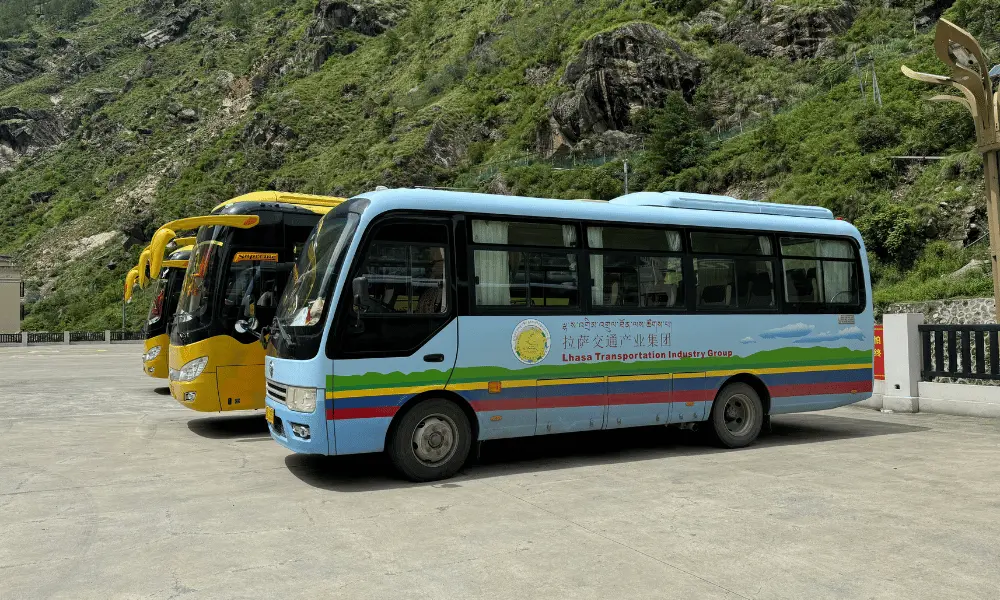
Kailash Mansarovar Yatra via Kyirong
The trip begins in Kathmandu, following the highway to the Rasuwagadhi border, considered the entrance between Nepal and Tibet by way of Kyirong. After passing through the processes of immigration and customs on the Nepal-Tibet border, the travelers enter the Tibetan Autonomous Region (TAR) of China. From that moment onward, road travel commences once more, with stunning views unfolding before the eyes and height steadily rising to assist the acclimatization process. Since the way cuts through the enormous Tibetan plateau, lovely, thinly populated towns such as Saga are passed through en route to the holy Lake Mansarovar. From Lake Mansarovar, the trail leads to Darchen, a launching place for the Kailash Parikrama of great ancient pride. This land route suits those who wish not to go by plane or helicopter and want to see the changing terrain. From the standpoint of budget, this is one of the cheaper ways of performing the Kailash Mansarovar Yatra.
Outline Itinerary
|
DAY 01: Kathmandu Arrival. |
|
DAY 02: Visa Application, Kathmandu Sightseeing. |
|
DAY 03: Bhaktapur Sightseeing, Nagarkot Stay. |
|
DAY 04: Chandragiri and Swayambhunath Sightseeing. |
|
DAY 05: Packing and Final Preparation. |
|
DAY 06: Drive to Dhunche or Syabrubesi or Timure. |
|
DAY 07: Drive to Kyirong. (2850 m) |
|
DAY 08: Kyirong Acclimatization. |
|
DAY 09: Drive to Saga. (4500 m) |
|
DAY 10: Drive to Lake Mansarovar. (4600 m) |
|
DAY 11: Drive to Darchen. (4700 m) |
|
DAY 12: Drive to Yama Dwara, Trek to Deruphuk. (5050 m) |
|
DAY 13: Trek to Zuthulpuk. (4800 m) |
|
DAY 14: Zuthulpuk to Saga. |
|
DAY 15: Drive back to Kyirong. (2850 m) |
|
DAY 16: Drive to Kathmandu. |
|
DAY 17: Transfer to Airport. |
Learn More: Kailash Mansarovar Yatra via Kyirong
Kailash Mansarovar by Air
Travel by air is faster and more convenient for one of the most sacred pilgrimages, allowing seekers of spirituality to experience smoother transit to the divine realms of Mount Kailash and Lake Mansarovar. Thus, the Yatra by air is ideal for those limited by time or with physical restrictions, so that pilgrims can concentrate more on the spiritual essence rather than on the physical difficulties and all the while maintaining the sanctity and core of this once-in-a-lifetime journey.
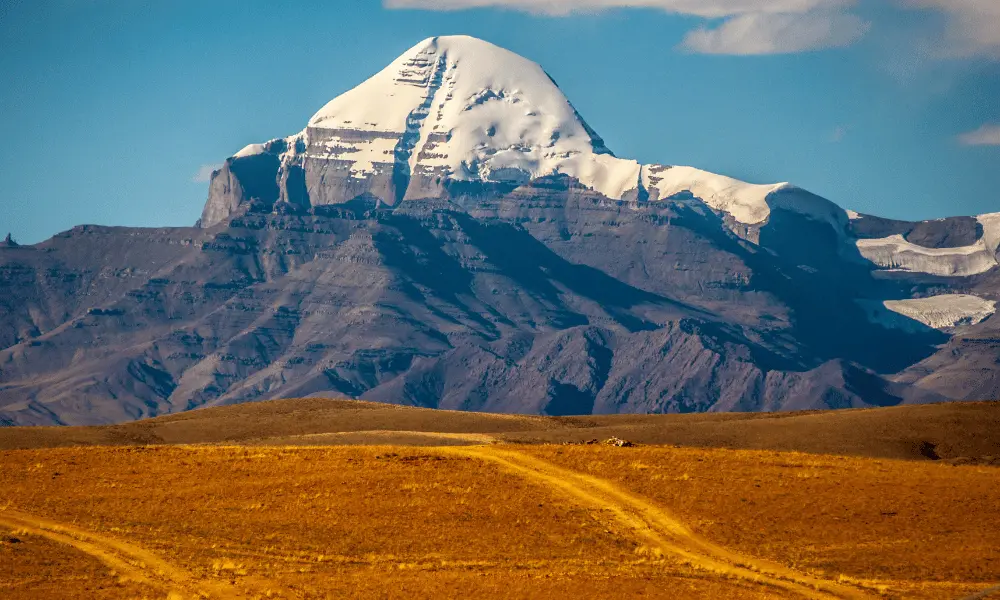
Kailash Mansarovar Yatra by Heli via Hilsa
Starting off, your trip to Kailash Mansarovar begins with a flight from Kathmandu to Nepalgunj, located in western Nepal. Afterward, you fly again to reach Simikot, a secluded mountain town. At Simikot, the helicopter will take you near the Tibet border, basically to Hilsa. Helicopter flights into Tibet are prohibited, so the ride ends in Hilsa. Then, after clearing immigration and customs on the border, you continue by land, driving through the beautiful Tibetan landscape till you come to the holy site of Kailash Mansarovar. This route is therefore considered the fastest and the most accessible way to do the Kailash Mansarovar Yatra.
Outline Itinerary
|
DAY 01: Kathmandu Arrival. |
|
DAY 02: Visa Application, Kathmandu Sightseeing. |
|
DAY 03: Bhaktapur Sightseeing. |
|
Day 04: Chandragiri Sightseeing. |
|
Day 05: Packing, Fly to Nepalgunj. |
|
Day 06: Fly from Nepalgunj to Simikot. (2971 m) |
|
Day 07: Simikot to Hilsa to Taklakot. (3800 m) |
|
Day 08: Acclimatisation day at Taklakot. |
|
Day 09: Drive from Taklakot to Lake Mansarovar. (4600 m) |
|
Day 10: Drive to Yama Dwara, Trek to Derapuk. (5050 m) |
|
Day 11: Trek to Zuthulpuk. (4800 m) |
|
Day 12: Zuthulpuk to Hilsa or Simikot. |
|
Day 13: Hilsa to Simikot, Fly back to Kathmandu via Nepalgunj. |
|
Day 14: Departure. |
Learn More: Kailash Mansarovar Yatra by Helicopter
Kailash Mansarovar Yatra by Flight via Lhasa
A scenic and extraordinary sightseeing flight will be available from Kathmandu to Lhasa. Upon the day's arrival in Lhasa, the next couple of days are free for visiting some of the incipient monasteries and other cultural sights within Lhasa, including Potala Palace, Jokhang Temple, and Sera Monastery, to acclimatize to the altitude level. Then, on the way to the grand highlands of Tibet, this journey continues via road, passing through towns of Shigatse and Saga. This road allows for a good and comfortable journey, so that one can ascend comfortably towards the sacred Lake Mansarovar. The journey continues from Mansarovar to Darchen, which is the base for Kailash Parikrama, comfortable and spiritually invigorating in an accompaniment that offers huge opportunities for acclimatization and sightseeing through historic Tibetan towns in one of the most beautiful and soulful ways to embark upon Kailash Mansarovar Yatra.
Outline Itinerary
|
DAY 01: Kathmandu Arrival. |
|
DAY 02: Visa Application, Kathmandu Sightseeing. |
|
Day 03: Bhaktapur Sightseeing. |
|
DAY 04: Visa Collection, Trip Preparation. |
|
DAY 05: Fly to Lhasa. |
|
DAY 06: Lhasa Sightseeing. |
|
DAY 07: Lhasa Sightseeing. |
|
DAY 08: Drive to Shigatse, Enroute Sightseeing. |
|
DAY 09: Drive to Tingri (4348 m), Explore Everest Base Camp. |
|
DAY 10: Drive to Saga. (4500 m) |
|
DAY 11: Drive from Saga to Lake Mansarovar. (4650 m) |
|
DAY 12: Drive to Darchen. (4700 m) |
|
DAY 13: Drive to Yama Dwara, Trek to Deruphuk. (5050 m) |
|
DAY 14: Trek to Zuthulphuk, Drive to Darchen. (4650 m) |
|
DAY 15: Drive to Kyirong. |
|
DAY 16: Drive to Kathmandu. |
|
DAY 17: Departure. |
Learn More: Kailash Mansarovar Yatra by Flight via Lhasa
Packing Essentials
Being somewhat of an odyssey in itself, the Kailash Mansarovar Yatra demands proper packing to facilitate comfortable travel, safety, and well-preparedness for any given situation encountered on the way. The weather along the way to Kailash Mansarovar Yatra changes considerably whereby pilgrims face climates ranging from mild to adverse higher altitudes. The pilgrimage months considered ideal or best are from May to September, wherein during the day, the temperature ranges between 15°C to 20°C. However, the nights and early mornings generally felt colder. The treks may involve hard scrambles and climbs; hence, layered clothing will be most useful, permitting the pilgrim to maintain comfort while adapting to temperature changes during the day.

- Layered Clothing: To cater to a change in temperature.
- High-Level Trekking Equipment: Waterproof boots, warm socks, durable backpack.
- A First-Aid Kit: Prescribed medicines, blister plasters, painkillers, rehydration salts, altitude sickness medicine (Diamox – consult a doctor).
- Sunblock: High SPF sunscreen, sunglasses (polarized), and a wide-brimmed hat. The sun is a powerful one at altitude.
- Camera and a power bank: To save a good memory; keep your power bank fully charged.
- Hydration: Water bottles with a capacity of at least 2l and purification tablets/filters.
- Snacks: Energy bars, dry fruits, chocolates.
- Toiletries: Biodegradable, if possible, and hand sanitizers.
- Sleeping Bag: Even when a blanket is offered, a good sleeping bag (-10 °C or colder) offers additional comfort and warmth, especially in basic guesthouses.
- Headlamp/Torch: You will need one, as blackouts are routine.
- Trekking poles: Highly recommended for use in unstable situations, especially during descents.
- Small daypack: To carry the essential things during Kora.
Learn More: Kailash Mansarovar Yatra Packing List Guide
Health and Insurance
Due to the peculiar hardships of rough terrain and high elevation, Kailash Mansarovar Yatra must be taken with due regard for health and insurance. Physical fitness in the form of cardiovascular exercises, some weights, or altitude simulation should be worked on. Likewise, the pilgrims should look out for the risks associated with the altitude like altitude sickness and take preventive measures like giving themselves an accommodation period or keeping well hydrated. Here are some health precaution and travel insurance related to Kailash Mansarovar:

Physical Fitness
The Kailash Mansarovar Yatra, Kailash Kora being the hardest part, is one of those deadly challenges that test even the most seasoned trekkers. The trail goes through rugged terrain with uneven surfaces, steep ascents, and descents at very high altitudes where the air is thin. Hence, one would do well with extremely rigorous exercise for at least 3-6 months prior to the date of their departure. Conclusion-wise, preparations must be geared toward:
- Strength Training
- Cardiovascular exercises
- Hiking Practices
- Breathing practice
Medical Check-up
Before even considering booking your Yatra, it is of utmost importance to undergo a full medical examination by a doctor. The importance of seeing your own doctor is:
- Assess overall health
- Discussing pre-existing conditions
- Medication Review
Altitude Sickness
Acute Mountain Sickness is a genuine concern and common at altitudes above 2,500 meters and the Yatra is at a much higher altitude. Prevention, recognition, and management of AMS are very important. To prevent the sickness one needs to:
- Aware of the symptoms
- Acclimatization
- Hydration
- Avoiding smoking and drinking
- Listen to your body
Travel Insurance
Given the extreme remoteness of the Yatra and risks involved with high-altitude travel, comprehensive travel insurance is highly recommended, if not downright required. Ensure that your policy covers the following for the Kailash Mansarovar Yatra:
- High Altitude Trekking
- Medical Emergencies
- Emergency Evacuation (From above 4000 metre)
- Lost Baggage and Personal Belongings
Challenges of Kailash Yatra
Kailash Mansarovar is a place of rare beauty and sacredness. Altitude, terrain, weather-the sheer price of existence. One must be able to go through these challenges to see that the journey is safe and successful.
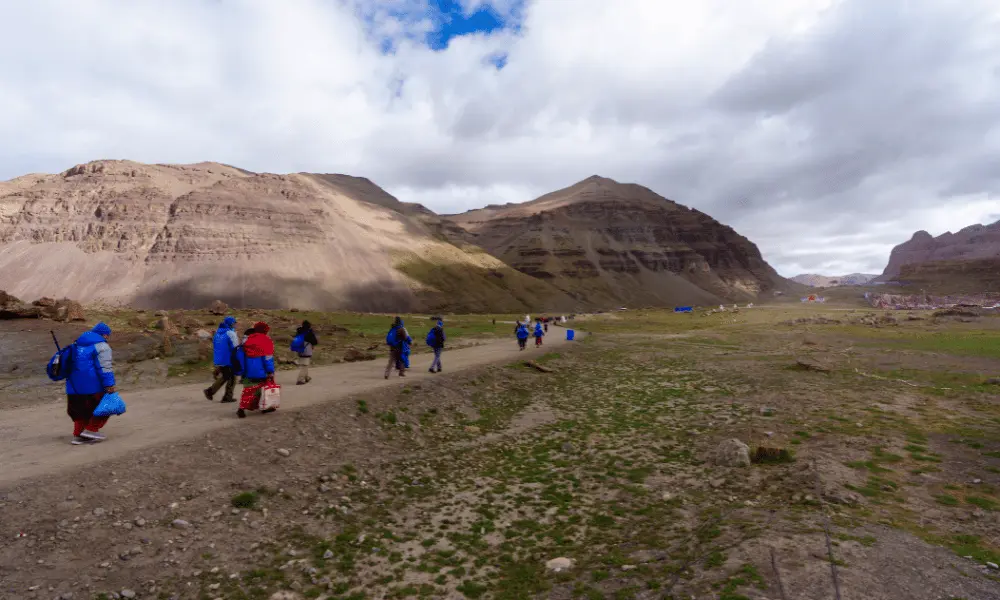
Altitude
The Kailash Yatra involves a considerable altitude challenge, with the most difficult section being the Kailash Kora 52-kilometer circumambulation of Mount Kailash, which reaches its highest elevation at Dolma Pass (5,600 meters). This very high altitude entails low concentration of oxygen, thereby predisposing trekkers to altitude sickness, which is usually accompanied by headache, nausea, dizziness, and fatigue. Trekkers must properly acclimatize by ascending gradually and taking rest days to adjust. Cardiovascular and strength training is also important to prepare the body to withstand the rough terrain, severe ascents, and sometimes unfavorable weather encountered during the pilgrimage.
Terrain
The trails around Mount Kailash offer diverse terrain from rocky slopes to steep ascents. Pilgrims have to cross arduous terrain involving endurance, strength, and agility. Essentially, the scenery comprises a sharp juxtaposition of barren, towering arid moonscapes, vast grasslands with magnificent views of snowy peaks, peaceful valleys, and the crystal-clear blues of Lake Manasarovar and Lake Rakshastal. Fitness plays a crucial role in navigating these terrains without an injury and actively enjoying the spiritual and cultural experiences on the way.
Weather
The unpredictable Himalayan weather plays a major role in determining the fate of the Kailash Mansarovar Yatra. The pilgrims walking on this sacred way are subjected to abrupt temperature variations-from comfortable heat to double and triple digits cold at altitudes. The rocky environment brings with itself an unexpected weather of rain, snow, or burning sunlight all within particularly small periods, demanding very fast adaptability from the pilgrims. Due to varying temperatures, one must pack smartly, such as wearing and carrying layered clothing or suitable waterproof items. Pilgrims must accept with fortitude to take heed of the unexpected nature the elements confront as they choose to embark on their excursion of faith through the stunning Kailash Mansarovar.
Food and Accommodation
Due to very remote terrain along with ruggedness, food and accommodation are one of the issues faced during Kailash Mansarovar Yatra. Limited food options and few accommodations ranging from guesthouses to basic hotels are available for pilgrims. They are encouraged to be adaptable and somewhat flexible about accommodations since the pilgrimage stresses spiritual growth rather than worldly comforts. Preparation is the key: carry a bit more than needed, keeping yourselves fortified with some small refreshments. This will help the pilgrims adapt better to the remote conditions faced on the holy trek.
Communication Facility
Communication on the Nepal side during your Kailash journey won't be a problem. However, due to the remote location of Tibet and crossing International borders, communication becomes complex. Mobile network coverage exists during the Kailash Mansarovar Yatra, only if one purchases a Chinese SIM card. However, internet and call connectivity will be limited. To buy the SIM, one has to provide a copy of passport and a passport-sized photograph. Depending upon your route, you can procure the SIM card at various points during the journey: for example, Kyirong (if traveling via Kyirong), Lhasa (if traveling via Lhasa), or Taklakot (if traveling via Simikot). Communication with family can be done through WeChat as much as possible; when connected to WiFi (which, by the way, is usually better in bigger towns like Lhasa), it allows very easy communication. Being wise, one would want to download the WeChat app before the Yatra and talk their families into doing so also so as to keep in touch during the whole journey.
Learn More: Kailash Mansarovar Yatra Difficulty
Things Not to Do
In terms of Kailash Mansarovar Yatra, one should observe local customs, safety, and regulations. It is considered disrespectful to do anything that might offend the local religious sentiments, compromise health, or contravene the law, ensuring that one treads the path of the safe and respectful way.

Here are some activities not to do on the yatra.
- Don't disrespect sanctity: Mount Kailash and Lake Mansarovar are held in deep reverence from Hindus, Buddhists, Jains, and Bon followers. No loud behavior, littering, or anything that could be construed as an act of disrespect is to be committed.
- Don’t try to climb Mount Kailash: Climbing the mountain is strictly forbidden and is considered one of the greatest acts of disrespect.
- Do not ignore altitude sickness: High altitude can be dangerous. Do not force yourself to work if you begin to feel unwell; inform your guide or group leader.
- Do not travel without proper permits: You will need documents to travel, chiefly the permits provided by the Chinese authorities. Travel without them and you will find yourself in serious legal trouble.
- Do not wander alone: For safety concerns, especially in such remote high-altitude areas, try to stick to your group or guide at all times.
- Don’t carry banned articles: Do not carry any political material, religious pamphlets (especially related to Dalai Lama), drones, or satellite phones since they may be banned or open to legal action in Tibet.
- Don’t photograph carelessly: Some monasteries and sensitive areas do not allow photography; do respect local rules and signs.
- Do not pack too much or carry heavy baggage: One should try to keep the load as light and manageable as possible for easy trekking and altitude adjustment.
Conclusion
A trip to Kailash Mansarovar becomes a once-in-a-lifetime spiritual experience, accompanied by adventure and some of Earth's most sublime vistas. One must, however, be well prepared before setting forth on this sacred journey. There's a whole list of factors-one needs to consider from obtaining the required permits to keeping high altitude in mind during planning, and braving the peculiarities of the weather. Sometimes that extra preparation can go a very long way. Acclimatization to the elevation, working out for endurance, and having the right equipment itself will make the whole pilgrimage safe and comfortable. Besides physical preparations, equally important is to enter the sacred domain with reverence and carefulness. It is not a mere tourist place but a very sacred place for Hindus, Buddhists, Jains, and Bon followers. With the attitude of humility and awareness maintained, Kailash Mansarovar not only can provide awe-inspiring sights but also very powerful personal insight and spiritual benefits.

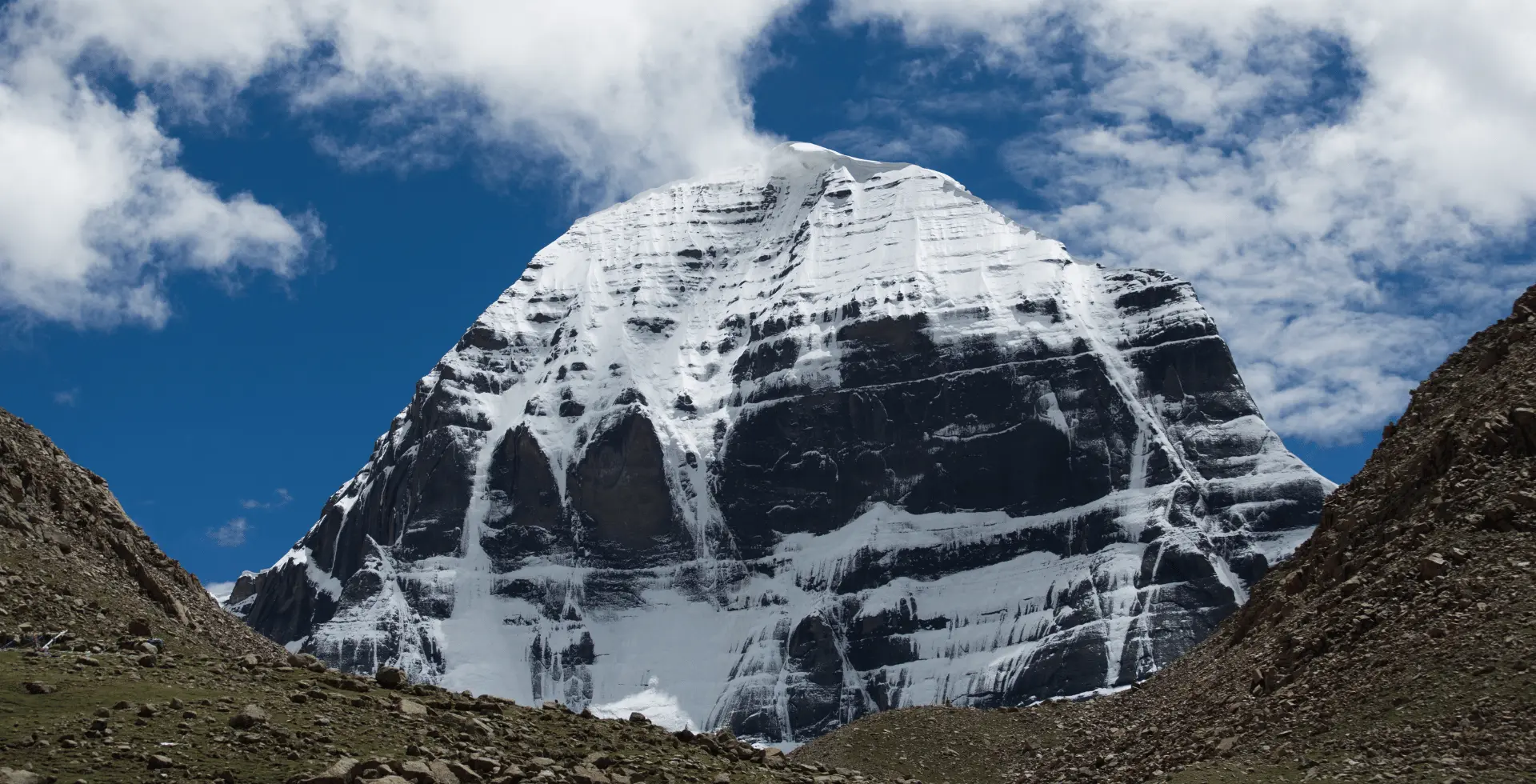
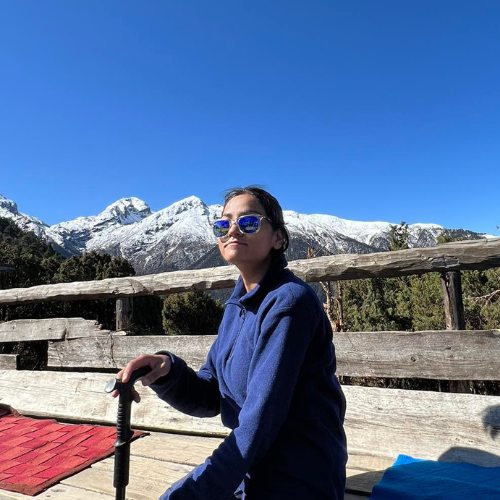 Mandira Itani
Mandira Itani